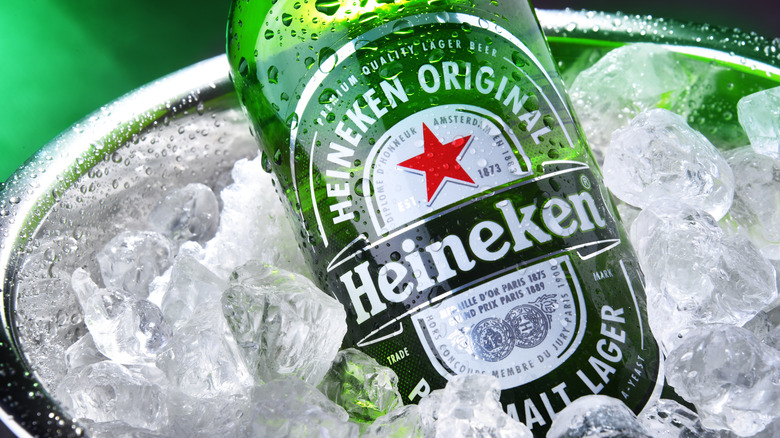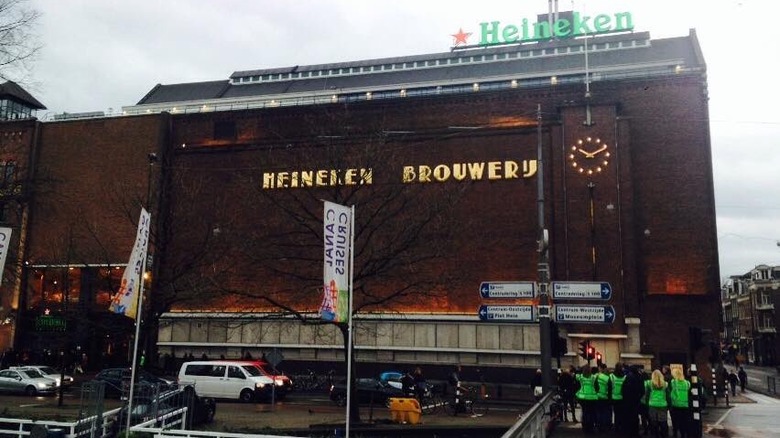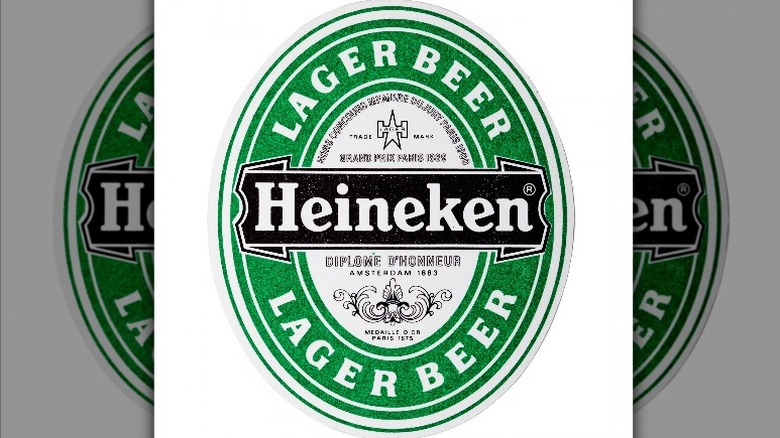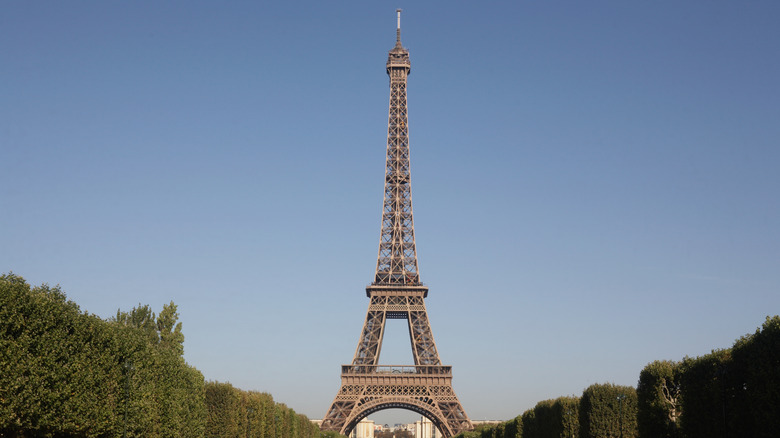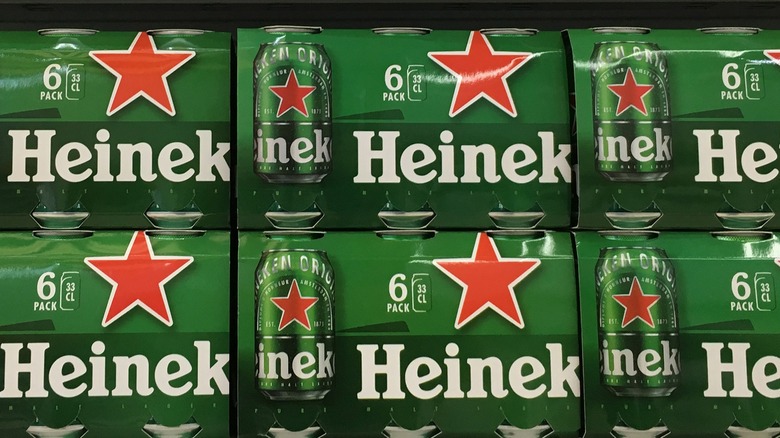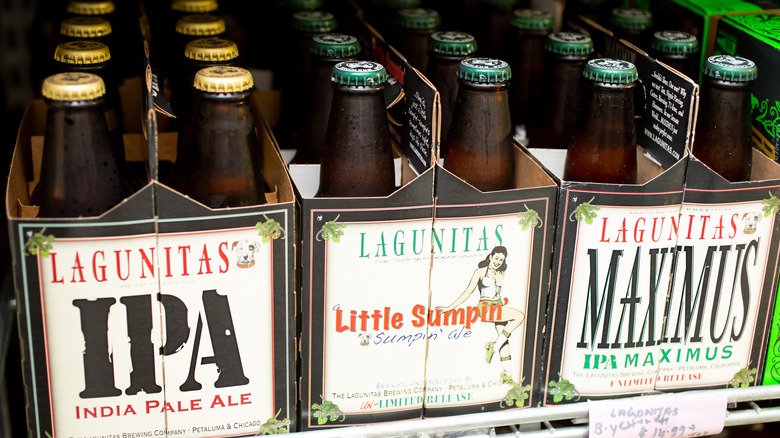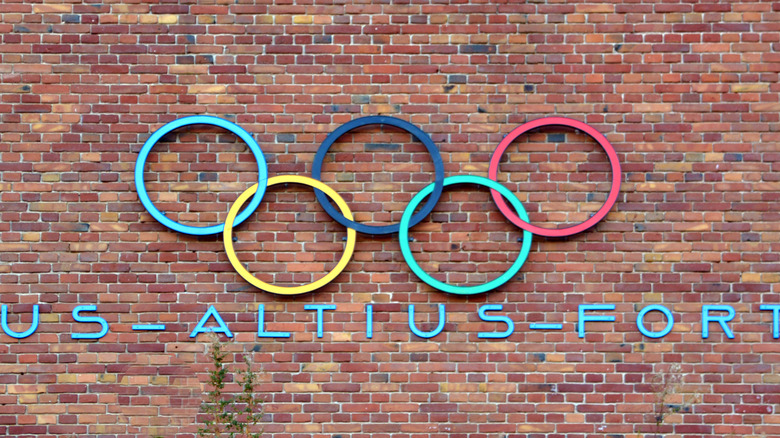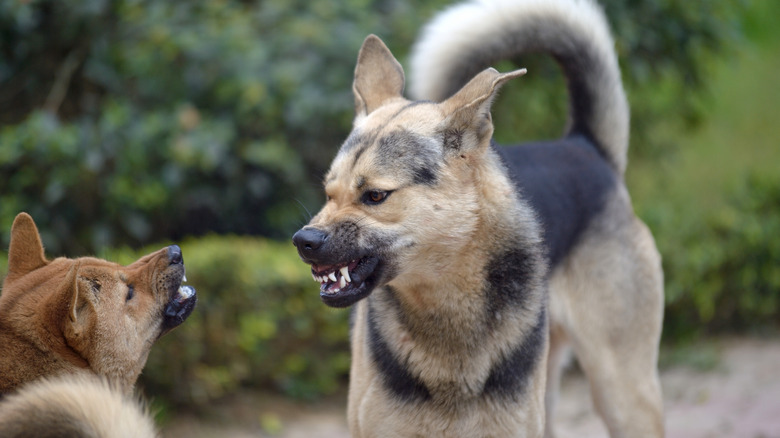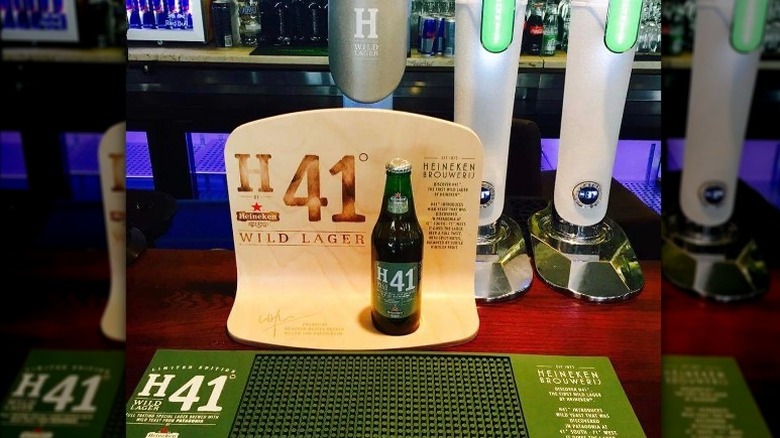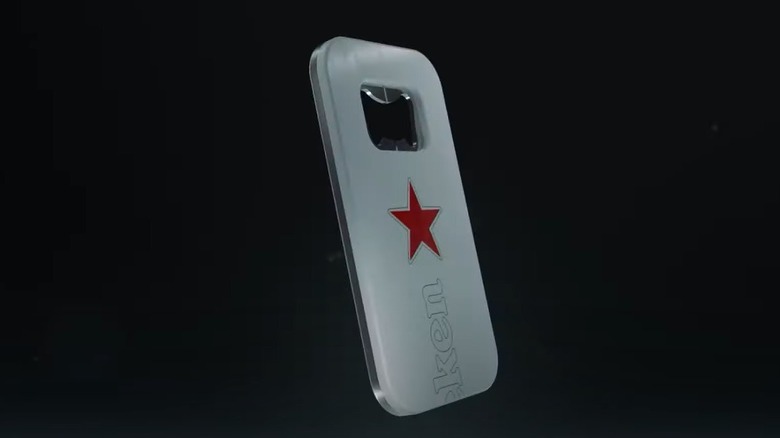Heineken: 12 Facts About The Popular Beer Brand
If the thought of a red star on green conjures the image of a communist Kermit the Frog, then you may be unfamiliar with Heineken beer. Now, how could someone possibly be unaware of the internationally-sold, green-bottled lager in the 21st century? That isn't a question we can answer. But if you're wondering how the Amsterdam-based brewery became one of the most popular and well-known beer companies in the world, then we've got you covered.
First brewed under the Heineken name in 1873, the brewing company has blossomed into something that may have been unfathomable to founder Gerald Heineken. That's not to say the brewmaster didn't believe his product could become widely enjoyed, of course. But if the Heineken namesake genuinely expected his brewery would remain in business more than a century after he started it all, not to mention that its products would be sold in more than 190 countries throughout the world as of 2021? We'd be fairly impressed at his Nostradamus-like ability to predict the future.
Obviously, we love shining a spotlight on beloved companies, particularly ones with a track record as phenomenal (and long) as Heineken's. For anyone intrigued by its history, crack open a green bottle or can, and allow us to illuminate some of the more interesting facts about the popular beer brand known as Heineken.
The original brewery was called the 'Haystack'
The rationale behind the name Heineken is exceedingly easy to understand. After all, the company was originally founded by Gerard Heineken. No one can really fault the entrepreneur for choosing to self-brand his business. But contrary to what some may believe, that's not the whole story. When the soon-to-be beer tycoon first entered the brewing industry, he didn't start from scratch with the Heineken name. Rather, according to the company, Heineken purchased an already established brewery called De Hooiberg (the Haystack) in 1964.
Heineken used the fairly substantial sum of money he inherited upon his father's death to acquire the water-adjacent property at the beginning of 1864 (via Heineken). The young man's excitement regarding his potential acquisition didn't dull his business sense, though. He insisted that he should be the sole owner of the property upon purchase, as he explained to his mother in an 1863 letter.
It would be nearly a decade before the Heineken name was used when the company was renamed for its owner in 1873 (via Craft Beer & Brewing). That same year, Heineken opened a second brewery in Rotterdam, Netherlands. By then, the march toward international acclaim was well underway.
Heineken won many awards during its first decades
Most humans are instilled with a desire to compete against one another. No matter how absurd a competition may be — the World Rock Paper Scissors Association, anyone? — many of us are primed to prove our prowess over other people by any means necessary. Gerard Heineken was no exception, so it's obvious why he was eager to prove his product's worth against the competition. And prove it he did, as his brewery's superior beer won a number of international competitions during its first few decades (via Heineken).
The bevy of accolades began in 1875, according to the Heineken Collection Foundation, when Heineken's German-style "Bavarian beer" won the gold medal at a Paris competition. This was followed by a Certificate of Honor bestowed by an Amsterdam competition in 1883, as well as further recognition at the Grand Prix Paris in 1889.
Heineken isn't exactly shy about its award-winning past, of course. In fact, if you can't remember the list of awards won by the company, just look at a Heineken label, where each of its pre-20th century honors is clearly listed for consumers.
Heineken was first sold internationally in 1875
The notion that Heineken is an internationally-available beer is a familiar one to U.S. consumers — the brewing company's famously headquartered in the Netherlands, after all. But back in 1864, when Gerard Heineken's then-new beer was first brewed, it was only available within his native Netherlands. Of course, greatness can only be held back for so long, and by 1875 Heineken's lager was available for sale in the not-quite-neighboring country of France, according to Heineken.
The timing of Heineken's expansion into France wasn't completely coincidental, as the brewery's 1875 gold medal at a Paris competition triggered a newfound demand for the Dutch brew (via Heineken Collection Foundation). Soon after that, Heineken's popularity in France soared. At one point before the start of the 20th century, it even had a contract to provide one million glasses of beer annually to the famed Parisian music hall Folie-Bergères.
Since Heineken's products are now sold in more than 190 countries as of 2021 (via Heineken), it may not seem like a very big deal that it once expanded its market to a second country. But even a flood begins with a single raindrop.
The 'e' in the logo is supposed to resemble a smile
When we think of Heineken beer, our minds tend to drift towards the don't-worry, be-happy territory. Interestingly enough, that may not be entirely by chance, certainly not when you consider the thought process behind the brand's now-iconic label. According to the Heineken Collection Foundation, when the company first began printing "Heineken" on its label, the three lowercase letters "e" in the name were deliberately slanted to give the impression of a smile.
The brainchild of Alfred Heineken (grandson of founder Gerard), the smiling "e" was designed to instill a feeling of joy in customers. When you consider Alfred's purported personal motto — "I don't sell beer, I sell enjoyment" (via Heineken) — this decision makes perfect sense.
The slanted "e" wasn't the only notable marketing change imparted by Alfred to his family's company. In addition to deciding the beer's name should be printed on the label instead of its type, according to the European Route of Industrial Heritage, he also introduced the color green into Heineken's marketing.
Heineken was the first imported beer in the U.S. after Prohibition
Everyone wants to be the first to accomplish something, but simple logic dictates there's only room for one person to be, well, number one. Since corporations are people, too — according to the U.S. Supreme Court, at least (via NPR) — it's no surprise that Heineken also harbors this desire. Why else would it have sent a shipload of beer to New York in 1933 if not to become the first imported beer sold in the U.S. upon the repeal of the nation's alcohol ban (via Heineken)?
That question sort of answers itself. Sure, the company's website hints at an altruistic push to provide beer-deprived Americans with a quality product (after more than a decade without a legal option). But it's not like Heineken was giving its imported brews away to thirsty consumers. Nor would anyone have expected it to do so.
Clearly, getting its foot back in the door of the American market as soon as beer was once again legal was of paramount importance to Heineken. That sense of urgency paid off. Within four years of Prohibition's end, Heineken's exports to the U.S. had increased an astounding 600% (via Heineken).
It's one of the most popular beers in the world
To say Heineken is enormously popular in both the U.S. and around the world is exceedingly obvious. In fact, according to YouGovAmerica, not only was a whopping 95% of the U.S. population aware of the Heineken brand as of 2019, but it was the most favorably-rated beer in the nation that year.
It's not just U.S.-based consumers who hold an immense fondness for Heineken. In 2021, the company earned nearly 20 billion euros. Given the nearly one-to-one exchange rate of euros to U.S. dollars as of November 2022 (via European Central Bank), that means the brewing company earned a staggering $20 billion.
Beyond the sheer dollars and cents behind its global giant status, Heineken can also claim the title of the second-most valuable beer in the world. It's also the second-most popular brand on the app Untappd (via VinePair). For anyone harboring doubts about Heineken's stature among worldwide beer brands, the data doesn't lie.
Heineken owns other prominent beer brands
If you think that Heineken was able to earn 20 billion euros in revenue in 2021 by selling solely Heineken-branded products, the reality is a bit different. We're not saying Heineken isn't monumentally popular, but in addition to its flagship product, the brewing company also owns, produces, and sells a fairly expansive roster of other well-known beers.
The brewery's corporate reach extends to nearly all corners of the world. Some of its internationally-sold brands include Edelweiss and Amstel Light, the former being company's most popular non-Heineken brand. Additionally, Heineken owns and markets popular beer brands throughout Africa, Asia, and both of the American continents (via Heineken).
The substantial list of beloved beer brands owned by Heineken — including Lagunitas, Red Stripe, and Dos Equis (via Heineken) — may surprise some U.S. consumers. Then again, when you consider the nature of corporate growth, a business operating for over a century should add to its corporate portfolio over time. Looking at other mega-brands, Heineken's ever-expanding collection of beer labels is the norm.
Heineken's World Bottle can be reused as a building block
There's nothing particularly noteworthy about a European company that seems more conscientious of its environmental impact than a U.S. one. But that doesn't mean Heineken's World Bottle (WOBO) prototype from 1963 isn't still fascinating. After all, the WOBO was designed to help reduce waste by transforming it into a building block once its contents were gone (via Heineken).
The WOBO was inspired by a Caribbean trip Alfred Heineken took in the early 1960s, according to the Heineken Collection Foundation. Disgusted by the vast quantities of trash scattered across the Antilles, he set out to devise a beer bottle that could help eliminate such litter. Designed in collaboration with architect John Habraken, the WOBO was fairly easy to convert into a building brick, as demonstrated by the Victoria and Albert Museum.
Frankly, the World Bottle was ahead of its time. While logistical issues prevented it from getting into the hands of consumers, the WOBO legacy is easy to see in our modern world, where recyclable materials are now widely used.
It celebrated the 1928 Olympics with innovative advertising
There's no shortage of potential advertising opportunities for a business. This isn't some phenomenon relegated to modern times, however, as companies have always been eager to make a splash. The adage to "go big or go home" certainly applied to Heineken in 1928. That year, while the Olympic games were held in Amsterdam, the brewery decided to make an extremely big advertisement. It used a skywriter to spell out "Heineken's Bier" in towering letters above the Olympic crowd (via Heineken Collection Foundation).
The sky-high advertisement for Heineken wasn't just new for the company, but the first time any brewery had made use of skywriting for marketing purposes. According to Vox, skywriting had only been invented towards the end of World War I, meaning the eye-catching marketing method was still new at the time of the 1928 Olympics.
Heineken's skywriting stunt was a massive moment for the brewery, as well as the Amsterdam-hosted Olympic games. The event was commemorated by an array of memorabilia, including a lithographed postcard (via Lelands).
A Heineken banner at a dog fight caused controversy in 2010
When a company's been in business as long as Heineken, it's bound to face a controversy or two. However, we came across far fewer instances of public backlash against Heineken than we expected. Even when the brewing company has found itself in hot water, it wasn't necessarily at fault, as was the case in the early 2010s when it was falsely accused of sponsoring a dog fight in Mongolia (via Beer Street Journal).
Now, before you start lumping Heineken marketing executives in with ex-NFL quarterback (and former dog fight ringleader) Michael Vick, some context is necessary. In 2012, photos began circulating showing Heineken banners at a dog fighting event at a Mongolian club. Yet, the brewing company believed its ads were surrounding a dance floor. Additionally, it was unaware that the club in question would be rented out for such an abhorrent event, according to Heineken, or that its banners would remain in place when the club wasn't used as a dance venue.
Soon after the damning photo hit the news, the club's owner confirmed Heineken was genuinely in the dark about its apparent dog fighting endorsement. There is little reason to doubt Heineken's side of the story.
It released a lager brewed with a new yeast strain in 2017
Heineken has been driven towards innovation since Gerard Heineken first purchased the Haystack brewery in 1864. In fact, the need to expand beyond the same old, same old is hardwired into its DNA. That makes it entirely plausible that the international beer conglomerate would be on the cutting edge of brewing today. It often has been, like when Heineken launched its Wild Lager series in 2017 with its H41 beer — brewed with a newly-discovered yeast strain (via CNBC).
As Heineken global brewmaster Willem van Waesberghe told CNBC, the brewing industry originally had only three types of yeast available before Heineken's discovery. We had no idea any wild yeast varieties remained undiscovered by humanity but, according to Beverage Industry, Heineken's H41 beer was brewed with a then-unknown yeast strain discovered in a Patagonian forest.
Despite the H41 lager release potentially signaling the start of a special series, we weren't able to find any information about subsequent Wild Lager beers. An H71 variety appears to have been sold at one point, according to Untappd. But as of 2022, waiting for any further Wild Lager releases seems more like wishful thinking than a realistic expectation.
The brewery released a smart bottle opener in 2022
In 2022, a company aiming to insert itself into the cultural zeitgeist is a fairly regular occurrence. In particular, the exponential growth of technology over recent decades has led many seemingly tech-averse companies to embrace the future. Heineken, unsurprisingly, has taken a strong step in that direction. This includes the release of a gimmicky "smart" bottle opener in 2022 called The Closer which, according to Heineken, was designed to help professionals maintain a proper work-life balance.
The rise of remote work during the COVID-19 pandemic found many in the U.S. lengthening their work day by several hours, as the company noted (via PR Newswire). This led Heineken to develop The Closer, a tongue-in-cheek digital bottle opener that featured Bluetooth connectivity. The smart appliance would tell users when their work day should be finished. When The Closer was used to open a bottle — presumably, a Heineken — it would shut down all work-related apps.
Some may choose to glorify the so-called hustle culture in modern culture but, if the past few years have taught us nothing else, it's that life is short. So if you find yourself unable to peel away from professional tasks after a certain time, Heineken's bottle opener may help.
